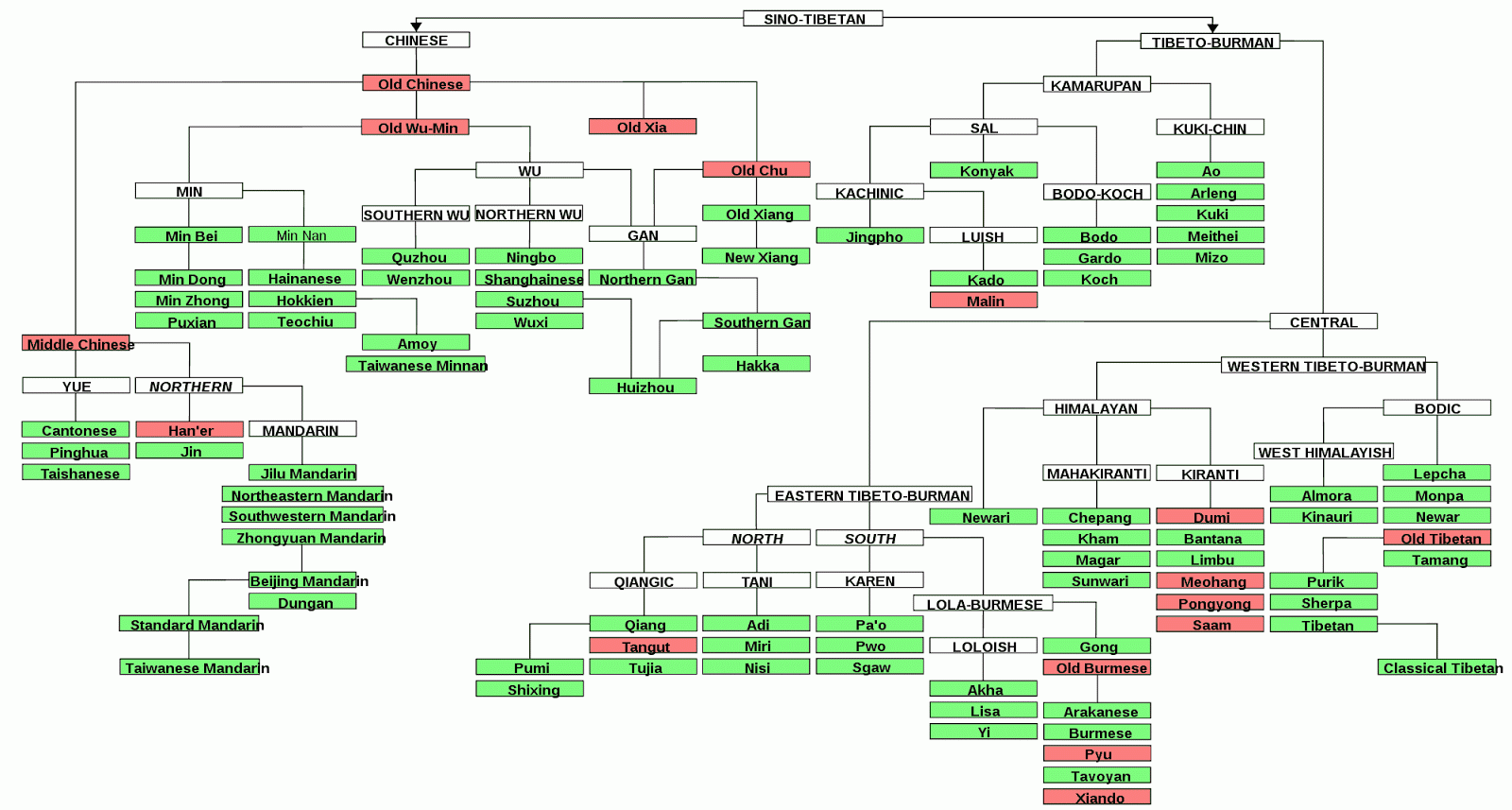Spoken Languages
There are thousands of spoken languages in the world and most can be traced back in history to show how they arerelated to each other.
For example:
English | Latin | Greek | Sanskrit |
| two | duo | dúo | dva |
| three | tres | treîs | tráyas |
By finding patterns like these, different languages can be grouped together as members of a language family.
There are threemain language families:
- Indo-European (Includes English)
- Sino-Tibetan (Includes Chinese)
- Afro-Asiatic (Includes Arabic)
Indo-European is the largest language family, followed by Sino-Tibetan, and lastly Afro-Asiatic. The Language Tree below shows languages that come from the same origin. (sorry about the quality. I’ve relabelled some popular languages) The numbers on the tree below are in millions of native speakers.
Interesting observations
- Sino-Tibetan branchincludes Mandarin and Thai
- Indo-European branch includes: English, Russian and Hindi
- Austronesian branch includes: Malay, Indonesian and Tagalog
- Japanese and Korean have their own branches
- Tamil is on another branch called Dravidian
NB: “It has been suggested that Thai could be part of the neighbouring family called Austronesian, rather than the Sino-Tibetan family. Perhaps the similarities that Thai shares with Chinese are due to borrowing, not descent from a common ancestor.” –Peter Thomas
Just like a family tree, we can think of branches as different families, and leaves as languages. By tracing these branches back we arrive at larger branches, such as Indo-European, and by tracing the Indo-European branch back, wearrive at even larger branches. Eventually, It isbelieved that you will arrive at the main trunk of this tree into which all of the languagescame from.
Mother language of all languages
A hypothesis put forward byProfessor Joseph Greenberg and his colleagues (Stanford University) holdsthat the original mother language developed in Africa among early hom*o sapiens. Their ‘Proto World’ map would show howhom*o sapiens spread across the world, taking their language with them.That single language, which the Professorcalls the Mother Tongue or proto-world, diverged naturally over time into the several thousands of diverse forms spoken today. Read more here
An idea of of what this treewould look like is shown below:
Source: Language Affinities Beween Autochthonous Populations
One ancestral language, spoken at least 15,000 years ago, gave rise to seven more that formed an ancient Eurasiatic “superfamily”.These in turn split into languages now spoken all over Eurasia, from Portugal to Siberia. Read more
Sino-Tibetan Languages
Sino-Tibetan is one of the largest language families in the world, with more first-language speakers than even Indo-European. The more than 1.1 billion speakers of Sinitic (the Chinese dialects) constitute the world’s largest speech community. Sino-Tibetanincludes both the Sinitic and the Tibeto-Burman languages.
Tibeto-Burman comprises hundreds of languages besides Tibetan and Burmese, spread over a vast geographical area (China, India, the Himalayan region, peninsular SE Asia). Read more
Hokkien is the oldest Sinitic language alive today. It provides an invaluable resource for scholars of ancient Chinese as well as comparative Sino-Tibetan. Mandarin and other Chinese dialects such as Cantonese have gone through the “middle Chinese” phase, Hokkien did not. She is a direct descendant of old Chinese. Read more
Indo European Language Family
As far back as 18th century it wassuggested that similarities among languages such as Sanskrit, Greek, Latin, Gothic, and others were so striking as to suggest that they had sprung from a common Proto-Indo-European language.By the 19th century, August Schleicher’s Family Tree had been proposed to model the relationships among the Indo-European languages as the branches of a tree. English is branched off Germanic.
The picture below shows how the Indo European Language Family tree branch comes from the main mother tongue trunk.
Source: Historical Linguistics and Global Language Families
Another beautiful illustration of theIndo European Language Family tree fromMinna Sundberg.
Conclusion
The original mother tongue may never be found. It becomes increasingly difficult todistinguish between inheritance from a common ancestor and borrowing from another group. There are no written records, so we can never know if word similarities happened by sheer chance or by accident.
However, what is known about the main language groupsis still fascinating, such as:
- The amazing fact that in the 18th century it was discovered that Sanskrit (the ancient language of India), resembles and hasrelationships with Greek and Latin.
- Malay, Indonesian, Javanese, and Tagalog are all related.
- Hokkien is a direct descendant of old Chinese, and is the oldest of the Sino-Tibetan languages alive today.








